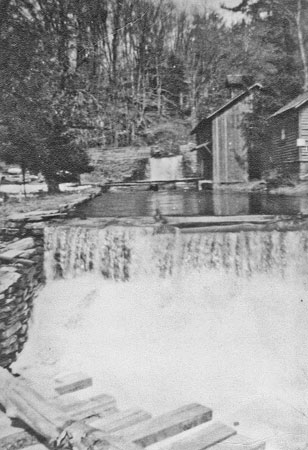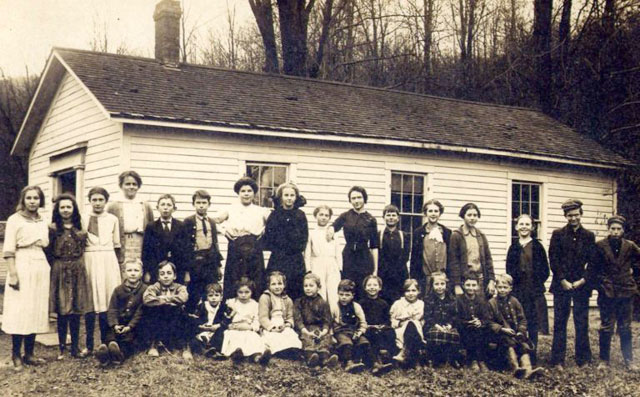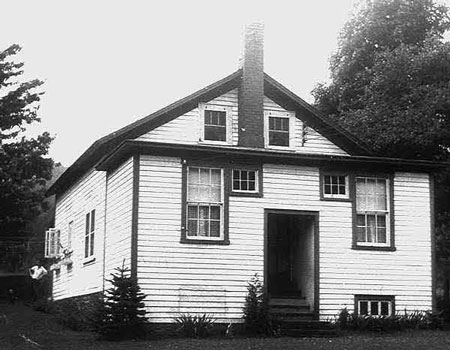|
Horton Early Settlers Horton was named for David Horton who settle at the
foot of Horton Brook and was one of the first raftsmen in that area.
He built a mill on Horton Brook and rafted large amounts of sawed timber
down the Delaware River. He was the father of seven sons, John,
Samuel, Boliver, Orrin, Andrew Jackson, Herschal and Perry who all joined
their father rafting on the Beaverkill. Herschal D Horton became very influential in the Horton area and was the justice of the peace, a farmer as well as famed lumberman and rafter. The large extended Fuller family populated the Horton area; at one time fourteen Fuller families lived between Horton and Corbett. The road from Horton to Corbett is still referred to as Fuller Hill Road. Other farm families in the Horton area include
Justin Merrill, Thomas Edwards, John Stadel,Horace Utter, Frank and George Baker, John
Elfrey as well as several small farms owned by the Hortons, Tompkins and
Brushes families. Wood Products and Acid Factories Samuel W. Cable bought 2,000 acres from Horace Utter on Russell Brook in 1880 and started a wood products business. Hemlock and hardwood were used to make shingles and wooden shoe pegs that were used to hold the soles on shoes. Cable employed one hundred people in his factory. His complex included a blacksmith shop, a horse barn, a boarding house and several other houses for his workers. A series of five dams were built by Cable, one of which was one hundred feet wide near the Russell Brook Falls.
Cable also owned five sawmills, one in Walton, Rock Rift, Liberty, Russell Brook and one at the head of Cable Lake. When the O & W double tracked between 1902 and 1904 Cable supplied two million feet of hemlock which was used for their bridges and tunnels. In 1898 George I. Treyz built a retorts acid factory on Russell Brook near Cooks Falls . The plant operated six days a week, consuming 32 cords of four foot wood per day from 1898 until 1924.The plant employed over one hundred men in the factory, lumbermen cutting four foot cord wood and teamsters to haul the wood to the factory. In 1911 Treyz contracted to install a John Roebling Bridge, this railway bridge that went over the Beaverkill River and connected his factories with the O&W railway in Cooks Falls. The bridge and narrow gauge railway travelled five miles up Russell Brook to his Horton factory. This side rail allow Treyz to ship his timber to his sawmill and sidewalk bluestone directly to the O&W station for shipments to New York City. In 1924 the factory was converted to the new style oven plant and increased its capacity to 36 cords per day. This new factory burned in 1925 and was rapidly rebuilt. George Treyz died shortly after the factory was rebuilt and the operation was taken over by his son Victor. Victor modernized the factory and installed an alcohol refining column which produced pure methanol. This product was sold as antifreeze under the name of Treyzone.
Treyz operations changes also included the use of bulldozers to get wood off the steep hills and down to the roads where his large fleet of trucks could be directly loaded and taken to the acid factory. Treyz also added a formaldehyde plant and in the late 1940's he expanded to include a plant to make acetic acid directly from the wood liquor. The Treyz's company was the last acid factory in operation in New York State. Victor Treyz died in 1949 and left his holding to his sisters. Laura Treyz took over the business and dismantled the still house and the plant converted over to the production of charcoal. Charcoal was once the least profitable product of the company but there was new demand for charcoal in the production of steel, basic chemicals, rayon, rubber, glass, copper, brass and bronze. The plant was sold to the Susquehanna Chemical company in 1951 which reported that 50% of the charcoal production was devoted to the manufacture of carbon disulphide used in making rayon. The Susquehanna Chemical Company continued the charcoal plant until it was torn down to make way for the Route 17 Quickway in 1967. Schools
The property for the one-room Horton School was given to the community by George I Treyz in 1916 with the provision that if the school was outgrown the building would be used as a community church. Later a two-room school was built up the hill from the original building on the Rex Stadel property.
The Russell Brook School was located on the Samuel W. Cable property across from the road that leads to Trout Pond and the Butternut Grove school was located where Russell Brook runs into the Beaverkill., both were part of District No. 12. Churches Horton Chapel |






